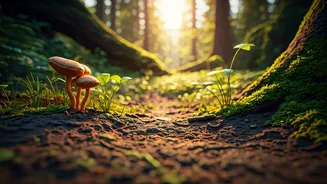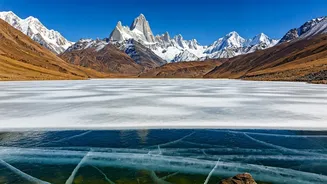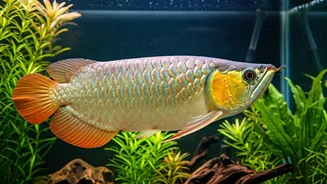The Humble Earthworm
Earthworms are nature's tireless tillers, profoundly impacting soil health. Through their constant burrowing, they aerate the soil, allowing water and
oxygen to penetrate. This activity prevents soil compaction, making it easier for plant roots to grow and absorb nutrients. Their castings, or waste, act as a natural fertilizer, enriching the soil with essential nutrients like nitrogen, phosphorus, and potassium. This not only boosts plant growth but also enhances the soil's structure, making it more resistant to erosion. Furthermore, earthworms help decompose organic matter, converting dead leaves and other debris into humus, a rich, dark substance vital for fertile soil. They also assist in breaking down pollutants, contributing to a healthier environment. These actions make them indispensable allies in maintaining a thriving ecosystem.
Busy Decomposers: Fungi
Fungi, particularly the mycelial networks of mushrooms, are indispensable decomposers within ecosystems. These often-hidden networks spread throughout the soil and decaying organic matter, breaking down dead plants and animals. This decomposition process releases essential nutrients back into the soil, which are then available for plants to absorb, initiating a continuous nutrient cycle. Fungi also form symbiotic relationships with plant roots, creating mycorrhizae. Through this partnership, fungi provide plants with crucial nutrients and water in exchange for sugars produced through photosynthesis. Certain species of fungi are even capable of breaking down pollutants, effectively cleaning up contaminated environments. Without fungi, the natural cycle of life, death, and renewal would grind to a halt, underscoring their critical role in ecological balance.
Microscopic Marvels: Bacteria
Bacteria, though microscopic, are incredibly influential in maintaining the health of our planet. They are essential for breaking down organic matter, similar to fungi, releasing vital nutrients back into the environment. Different types of bacteria play specific roles in nutrient cycles. For instance, nitrogen-fixing bacteria convert atmospheric nitrogen into forms plants can use, while others are involved in the cycling of carbon and phosphorus. Some bacteria assist in the decomposition of pollutants, and they also contribute to soil structure and health. They are found in almost every habitat, from the depths of the ocean to the upper atmosphere, reflecting their incredible adaptability and importance in the global ecosystem. These tiny organisms are a cornerstone of healthy ecosystems, ensuring essential elements cycle in nature.
The Pollination Powerhouse: Bees
Bees are key pollinators, instrumental in the reproduction of many flowering plants, including numerous crops. As they forage for nectar and pollen, bees inadvertently transfer pollen from the male parts of a flower to the female parts, leading to fertilization and the production of fruits and seeds. This pollination process is essential for the diversity of plant life and food production. Honeybees and various wild bee species contribute significantly to this process. Beyond agriculture, bees also contribute to the health of natural ecosystems by helping wild plants reproduce, supporting biodiversity and providing food and habitats for various other species. The decline of bee populations due to factors like habitat loss and pesticide use is a significant environmental concern, highlighting their crucial role.
Seed Dispersers: Birds
Birds contribute significantly to ecosystem health through seed dispersal. As birds consume fruits and berries, they swallow the seeds within. These seeds then pass through their digestive systems and are deposited in new locations, away from the parent plant. This dispersal mechanism allows plants to colonize new areas, expand their ranges, and avoid competition with their parent plants. Certain bird species also play a role in pollination. Birds' movement and foraging habits contribute to the distribution of essential nutrients across landscapes. Different species of birds have adapted to disperse specific types of seeds. The absence of birds can, therefore, disrupt ecosystems and inhibit the growth of certain plant species, emphasizing the importance of their role in maintaining biodiversity.
Engineers of Ecosystems: Beavers
Beavers are known for their construction of dams and lodges, which dramatically reshape their surroundings. These structures create wetlands, which enhance biodiversity by providing habitats for a variety of plants and animals. The impounded water also helps filter pollutants, improving water quality, and increasing water availability. By building dams, beavers also help to reduce erosion and regulate water flow, minimizing the risk of floods and droughts. Their activities create complex ecosystems, supporting a wide range of species, from fish to waterfowl. The impact of beavers extends far beyond their immediate environment, impacting the health and structure of entire watersheds. This earns them the title of 'ecosystem engineers,' demonstrating the profound influence they have on their surroundings.
The Cleanup Crew: Vultures
Vultures perform a vital ecological service by scavenging on the carcasses of dead animals. As they feed on carrion, vultures help to remove decaying matter from the environment, preventing the spread of diseases, and reducing the risk of disease transmission to other animals and humans. Their highly acidic digestive systems effectively neutralize harmful bacteria and pathogens present in the carrion. This scavenging activity helps maintain ecosystem balance, preventing the build-up of decaying organic matter and the associated health risks. Vultures also play a role in nutrient cycling, returning essential elements from dead animals back to the soil through their waste. Despite the negative perception surrounding them, vultures are essential for maintaining the health and functionality of ecosystems.
The Ocean's Forest: Kelp Forests
Kelp forests are underwater forests found in shallow, nutrient-rich waters. They are created by large brown algae called kelp, which can grow up to several feet per day, forming dense underwater forests that support a remarkable array of marine life. These forests provide shelter, food, and breeding grounds for various organisms, including fish, invertebrates, marine mammals, and seabirds. Kelp forests also act as a carbon sink, absorbing and storing significant amounts of carbon dioxide from the atmosphere, thus helping to mitigate climate change. They buffer coastal areas from storms and erosion, protecting the shoreline and providing crucial ecological services. The health and abundance of kelp forests are threatened by climate change, pollution, and overfishing, highlighting their need for conservation efforts.












